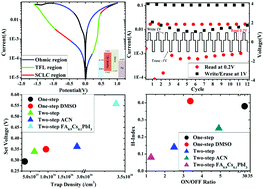Hybrid organic–inorganic perovskite materials offer a range of interesting characteristics that are suitable for optoelectronic devices, such as photovoltaics. Along with the fast rise in device performance, a current density–voltage (J–V) hysteresis originating from defects and their movement has attracted intense attention, which renders challenges regarding the stability and reliability of the novel materials. Here, we carefully probe the effects of defects in perovskite materials and across interfaces within the device, in which bistable conductive states are achieved for the next generation of nonvolatile memory. The memory device shows an operating voltage as low as 0.25 V, and a decent ON/OFF ratio. More importantly, we correlate the defect density and hysteresis-index of different perovskite films with the corresponding memory device performance. The findings enrich our understanding of the working mechanism of perovskite memory devices, which will also benefit other organic–inorganic hybrid perovskite optoelectronics.
